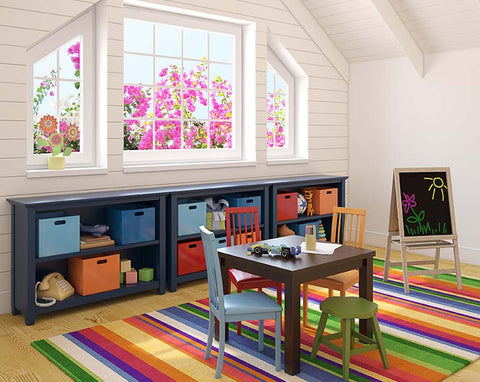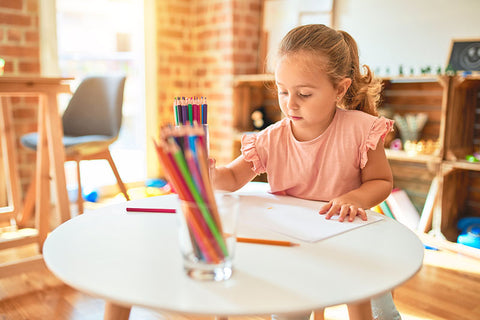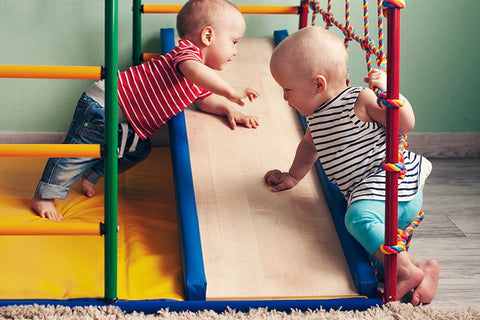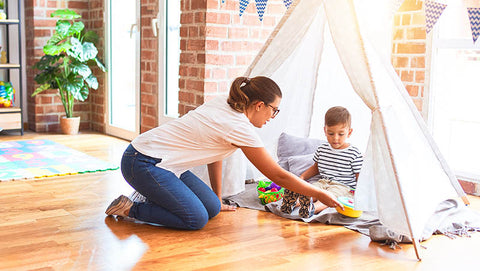Montessori Playroom - How to Set Up A Space Your Kids Love

Montessori Playroom
Montessori playrooms are amazing playing spaces for children. They provide a simple, clean, fun environment for kids to learn while they play. If done right, a Montessori playroom will help your child improve their concentration skill and start gaining independence from an early age.
This article will cover everything you need to know about Montessori playrooms and how they work. It shall also help you figure out how you can create your own Montessori playroom at home for your little one.
What is a Montessori playroom?
A Montessori playroom is a carefully designed child’s environment that encourages independence and concentration. It is a clean, simple playing space with a carefully selected, limited number of age-appropriate toys.

All the toys in a Montessori playroom are designed to help children develop skills like fine and gross motor skills. In this way, the Montessori playroom elevates play into more than just simple entertainment; it makes it engaging, too.

Here are some of the main features or characteristics of a Montessori playroom:
- It features a limited number of toys and activities. Everything in the playroom has been carefully selected for a specific reason
- It takes advantage of child-height Montessori furniture to have everything displayed nicely at your child’s level, always within their reach
- It is designed to be a cozy space that your child will enjoy to be in
- It includes some open space for free play
- The focus is on toys that promote engagement over entertainment
- To create order and routine, everything has its own set place. After your child is finished playing, everything goes back to its place for storage
- It mixes things up by providing a variety of activities that your child can engage in
How should a Montessori playroom be set up?
Here is how to set up your own Montessori playroom at home:
- Keep it simple

You want to keep things simple. Go for a limited number of toys and a limited number of activities that your child can do. This will allow them to focus on a few things and master them instead of jumping around from toy to toy and activity to activity.

According to most Montessori guides, the optimum number of activities to have in the playroom is 8-10. If you have more than 10 toys, creating a toy rotation about once per week will keep your little one engaged with all the activities. If you notice a toy or two that your little one is really engaging with, keep them on the shelf and rotate out the ones that are not being used as much. This will give your little one the opportunity to master all the toys they have.
You will also notice that a lot of Montessori playrooms use neutral colors as opposed to the bright colors associated with children’s play spaces. This makes the space soothing, fostering concentration.
- Use child-height Montessori furniture to keep things at their height

Everything that your little one uses should be at their level. You can achieve this with Montessori furniture and shelving. They will allow everything to be at your child’s height so they can see and reach them easily. This way, your little one can pick out whatever they like and put it back after they are done.
Do not hide their toys away in a toy box. Have everything prominently displayed. If you want to have flowers, plants, or artwork in their playroom, make sure that these are at their height, too, to allow your child to appreciate them.

Apart from shelving, you also want to include a child-sized table and chair in their space. This gives them the option of playing on the floor or on their table for things like puzzles.
- Include nature in the space

Whenever possible, choose a room with natural light. This will give them the opportunity to discover shadows and play with the changing lights, or watch the rain and learn about how nature works.
When your child has access to a window, it also creates the opportunity for them to talk about what they see. If the window is too high up, as long as you can ensure their safety, you can provide them with a step stool so they can look out the window and discover the world around them.

Include plants and animals in the playroom whenever you can. Hanging plants and herbs are great for this. The right choice of house plant will also teach your child to start caring about something while making the room beautiful at the same time.
Younger children can watch simple pets like fish moving around while older ones can care for them as well.
- Allow open space for movement

An open space in the playroom is great for developing gross motor skills. Allow them enough space to move around in, climb around, and explore. This sort of movement is actually essential for growing children. Ideally, place it somewhere in the middle so your little one can use their activities in the same space. You can also invest in a few comfortable cushions that can be moved around to create various setups.

If space is an issue, the open space does not have to be in the playroom. You can create it anywhere else in the house as long as your little one has the opportunity to develop their gross motor skills.
- Invest in toys that promote engagement over entertainment

Most Montessori playrooms almost exclusively use wooden toys. Of course, wooden toys and toys made from natural materials are environmentally friendly, beautiful, and long lasting. However, the main reason why Montessori playrooms try to stay away from plastic, battery-operated light-up toys that make a lot of noise is that the latter is great for keeping kids entertained, but the former keeps them engaged.

In fact, most Montessori toys are more entertaining than their plastic counterparts. Plus, you also get extra developmental benefits when you use them.
As you pick out the activities for your child’s Montessori playroom, be sure to carefully select them and include some variety in your selection.

If money is tight, you can still buy plastic toys that are within your budget. If you choose them carefully, they can still work if you only go for toys that are also beneficial to your child besides just being entertaining.
Alternatively, if you do not want to spend any money on toys, there are DIY activities that you can help your little one to make from scratch from readily available materials around the house. These can also be very beneficial to your child’s development.
- Create order and routine by giving everything its own place

Montessori talked a lot about “sensitive periods”, a specific time where a child is attracted to something and eager to learn about it. There is a sensitive period for order in children in early toddlerhood all through the age of five. This is when they love routine and repetition. Just as they like order in their lives, they crave order in their environments. However, they need some help in achieving the latter.
Your Montessori playroom should support this need for order by assigning everything a specific space where it should go. When you assign everything in your child’s playroom its own place, it becomes more comforting for them and they know exactly where to find everything.

Apart from that, order and routine are a great way to teach your child how to clean up after themselves. When they know exactly where on the shelf every toy belongs, they will be more likely to put them back in the same spot once they are done, and possibly even enjoy doing so.
In the end, you won’t have a messy playroom with toys scattered all over the place!
- Mix the activities up

The best Montessori playroom is one that allows the child a variety of activities to choose from. Include many different toys to allow your little one to work on various skills each week.
This does not mean that all the toys you put out have to work on a particular skill. It’s all about observing your child and finding out what they want to engage with most. If they like puzzles, it is OK to put out two or three extra puzzles. If they find a reading toy difficult to use because they are not ready for it, maybe put it away for a few weeks.

It’s all about learning what your child likes to engage with most by observing them and allowing them to do more of what they love.
- Make it a cozy space that your little one will enjoy to spend time in

Every Montessori playroom will look a little different. Use a nice, calming color on the walls, and perhaps have the place bathed in natural light. You can have a comfy couch or a few cushions around the space, or a soft mat that they can lay down on to read.

Some artwork and a few plants will also breathe life into the space. Keep in mind that everything has to be within reach for your child. If you have some beautiful artwork up, make sure it is at your child’s level so they can appreciate it better.
At the end of the day, though, you are the one who knows what will be a hit with your little one. There is no formula for making your Montessori playroom comfy, just do what works for you!
What should a Montessori playroom include?
The main thing to keep in mind as you make your Montessori playroom is variety. Here is a list of some of the things to include:

- Open space: If you have it, leave some open space for free play, movement and exploration.
- Artwork: This is relative and will depend on your child. For babies, black and white images are great. As they grow older, you can start incorporating images from nature, their own artwork, family photographs, interesting maps, and art pieces from different artists or cultures. All artwork should be placed at child-height.
- Montessori furniture: Invest in child-sized furniture, especially for shelving, tables, and chairs.
- Nature: It is very important to include nature in the space. Make sure that playroom is well-lit with natural light. You can also add a few house plants within your child’s reach, as well as a few simple pets like fish or turtles.
- The activities: Make sure to include a variety of different activities so your child can learn to master several different things
What type of furniture is good for a Montessori playroom?

The best type of furniture for a Montessori playroom is Montessori furniture that is child-sized and designed to help children become more independent by taking ownership of their space.
Montessori furniture works well in the playroom because most pieces are completely adjustable and multi-use. When your child uses them in the playroom, they become more self-confident, independent, and develop essential skills as they explore their environment.
Fostering this independence from an early age will make them more successful later in life. They will learn that it is OK to try new things on their own with confidence.
As a minimum, consider getting a bookcase/shelving area and a child-sized table and chair.
What are good Montessori toys?

Toys are a major element in all Montessori playrooms. So, what should you go for?
Well, the best Montessori toys (#ad) follow the Montessori principles. They are simple, made from natural materials, and encourage creativity and exploration. They have a lot of variation in their use, and many Montessori toys are also suitable for infants.

Good Montessori toys will also grow with your child. This means as they develop and unlock new skills, they will discover new uses for the toys.
So, how can you tell whether a toy is a good Montessori toy or not? Here are a few characteristics of the best Montessori toys. Try to find one that checks as many of these boxes as possible:
- They are simple: they can be as simple as three shapes in three solid colors to teach your child about shapes and colors.
- They are based in reality: young children cannot distinguish between fantasy and reality yet. In order to develop their imaginative skills, they first need to know what the real world is like. Instead of toys that make random noises when a button is pushed, go for a toy that will teach them the real-world consequences of a ball being dropped down a ramp.

- They are made of natural materials: natural materials like wood and metal have more variation to them than plastic. For example, their weight shifts with their size, so that a small wooden ball will be lighter than a larger one, while a big plastic ball could be completely weightless. Your child will get more information from natural materials than plastics

- They require child participation to work: your child actually gets to play with them instead of just pressing a button, sitting back, and watching the toy play itself
- They give the child more options for play: they are intentionally ambiguous to ensure that your child is the one who makes up all the rules and decides how to play with them
What activities can a kid do in a Montessori playroom?

There is a wide range of Montessori playroom activities that you can do with your little one. Just remember to include variety in them.
- Playing with toys: Get developmental toys that will help your child work on different skill-sets like concentration, problem solving, and gross and fine motor skills.
- Puzzle activities: These are great for older children, and you will notice their interest increase over time. They are best enjoyed with a table and chair. If you notice that your child is developing an interest in puzzles, consider adding more puzzles in their weekly toy rotation the following week

- Practical life skills: These can not only be learnt in the playroom but also throughout the home. Things like hand-washing, sweeping and mopping, putting the toys back in their place, general cleaning, and basic self-care like nose blowing and hair brushing all fall into this category.
- Language activities and books: Younger babies will appreciate picture books with black and white images. As they grow older, you can introduce more colorful books. Make sure that all their books are always within reach

- Kids light table: A light table can provide endless opportunities for kids to explore everyday things in new ways. Objects that are backlit from beneath like feathers and leaves create a sense of wonder in children. And, it makes playing with translucent building toys like Magna-Tiles® and LEGO® even more fun! (#ad) Learn more about a kids light table.

- Musical instruments: You can set up a music corner with simple musical instruments like drums, shakers, and xylophones. If they show an interest in music, introduce more instruments and sign them up for classes as they grow.

- Art and crafts: This is a great activity that you can do together. You can hang up their final works of art in their playroom afterwards.
How should things be stored in a Montessori playroom?

Everything should have its place in the Montessori playroom. All toys should be stored carefully in their allocated shelving space. Consider having a weekly or twice-a-month rotation of toys to keep things fresh.
When you rotate the toys, show your child the new toy and how it works, and also where on the shelf it is stored. Demonstrate how to put it back in its place when they are done.
There shouldn’t be an overwhelming excess of toys and activities in the playroom.

Here are a few more tips to help you organize things in the playroom:
- Label them: If you store your Montessori toys somewhere in the house in boxes waiting for the next rotation, consider labelling thee boxes to help you figure out what developmental benefits the toys have. Instead of writing directly on the boxes, things like index cards will give them more reusability.
- Use baskets or trays when shelving is not available.
- You can use the top hard-to-reach shelves for storage. Since your little one won’t have access to them, you can keep toys that are not in play here out of sight in boxes for later rotations.
- Get creative. Like all things Montessori, it’s all about finding a system and making it work for you.
Final Thoughts

That’s quite a lot to take in, isn’t it? The good news is that when creating your child’s Montessori playroom, you can pick and choose what works for you.
There is no hard and set rule for setting up your Montessori playroom. If you have an existing playroom, all you have to do to make it Montessori friendly is make everything accessible to your little one and limit the number of activities to between 8 and 10. Then get developmental toys that promote engagement and you’ll be good to go!
Remember, this is not a matter of all or nothing. Which means you do not have to deny your child the joy of playing with their favorite plastic toy car if that’s what they want. You know your child best, so do what works for you. Good luck!




